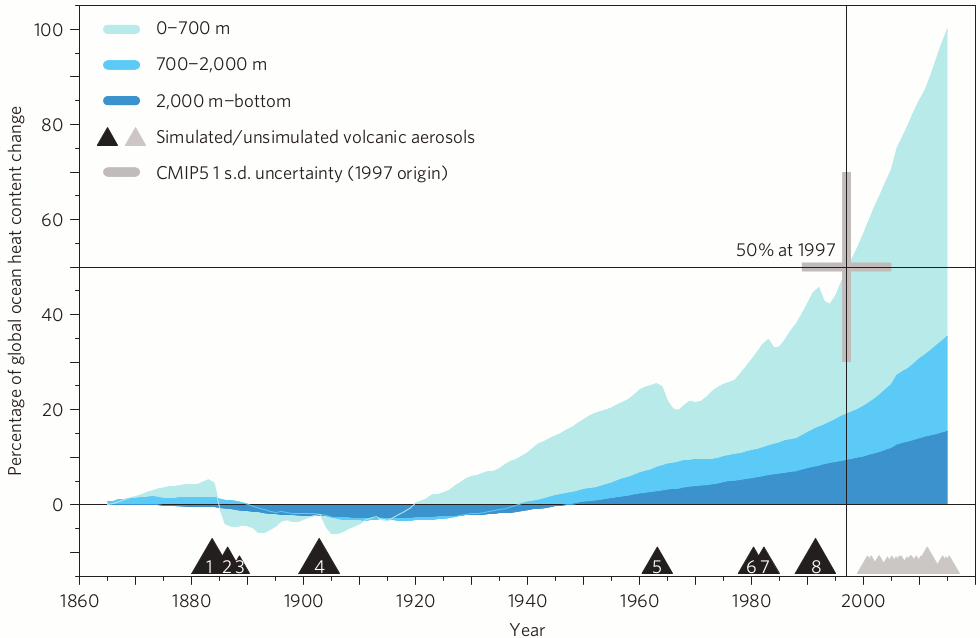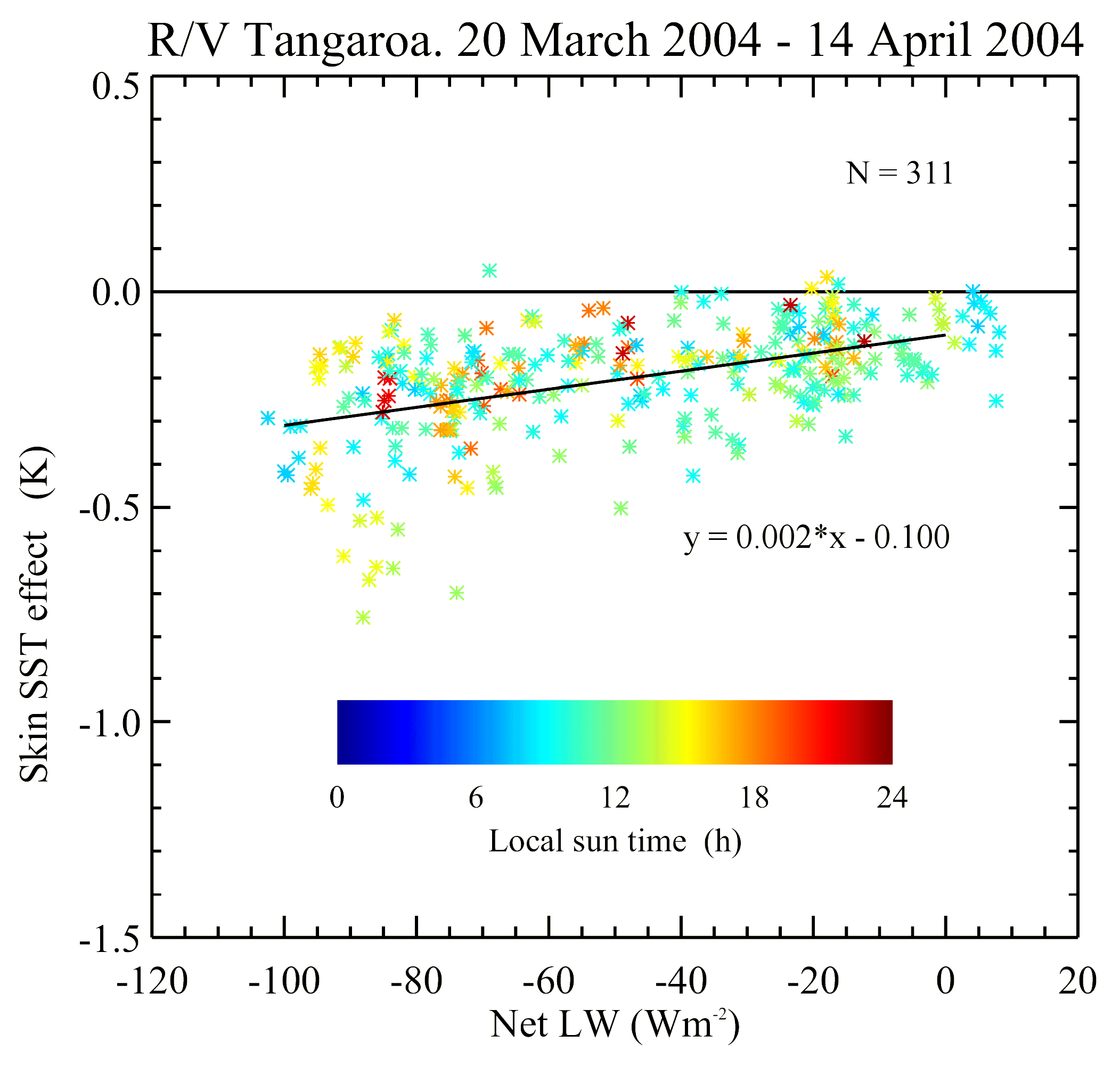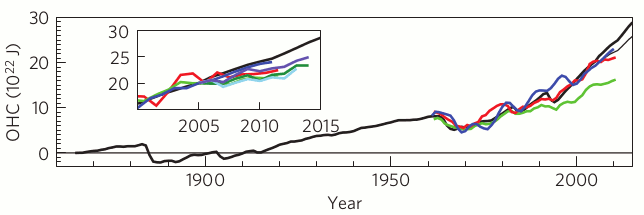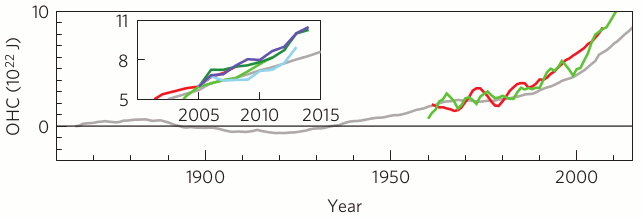Industrial-era ocean heat uptake has doubled since 1997
Posted on 4 February 2016 by Rob Painting
The oceans are by far the largest heat reservoir in the Earth's climate system, so much so that they make up a whopping 93% of global warming. Thus global warming is really the story of ocean warming. In many blog posts in recent years (see, here, here and here for example) Skeptical Science has consistently drawn attention to the fact that the oceans are continuing to accumulate heat and therefore, despite short-term fluctuations in both surface and atmospheric temperatures, global warming is proceeding largely as anticipated by the scientific community.
A recent paper, Gleckler et al [2016], manages to put the recent warming of the ocean into a broader, longer-term, perspective. Using ocean temperature measurements obtained from various sources and methods, and utilizing data from the pioneering HMS Challenger expeditions of the late 19th century (Roemmich et al [2012]), the researchers were able to compare the observations stretching back to the mid-1800's with climate model simulations. They found the model simulations were consistent with this diverse collection of ocean temperature data. Perhaps the most startling result of this analysis is just how much the oceans have warmed in recent decades, with the recent acceleration so pronounced that the rate of ocean heat uptake in the industrial-era has doubled since 1997.

Figure 1 - The CMIP5 multi-model mean ocean heat content change from 1865 to 2015 expressed as a percentage for 3 ocean depth layers. The gray bars indicate the 1-standard deviation uncertainty and the black triangles along the bottom denote simulated large volcanic eruptions (which disperse light-scattering sulfate particles). Gray triangles show the many unsimulated small & moderate volcanic eruptions after 2000. Image from Gleckler et al (2016).
Adding greenhouse gases to the atmosphere makes the ocean warmer
How additional greenhouse gases in the atmosphere cause the ocean to grow warmer is not generally well-known, so it's useful to provide some background context for this new research paper. In a similar vein to the warming of the atmosphere, the warming of the oceans occurs in response to the slowing of heat loss. It works like this: highly energetic solar (shortwave) radiation enters the surface layers and warms the ocean. The overlying air is typically cooler than the sea surface, so some ocean heat is lost to the atmosphere and any surplus is eventually radiated away to space high up in the atmosphere. The amount of heat in the ocean is therefore a balance between solar radiation entering the ocean and the energy which leaves it - mainly through evaporation. The oceans can warm through an increase in solar output (the sun has actually cooled in recent decades, thereby eliminating that as a potential cause) or by reducing the rate of heat loss to the atmosphere. This is where additional atmospheric greenhouse gases come in.
The heat lost at the ocean-atmosphere interface results in a less than millimeter-thin layer of ocean surface being colder than the water layers immediately beneath. This is known as the cool-skin layer. In the water just below, heat is moved about through turbulence - individual atoms and molecules jostle about taking their heat with them. They also collide with each other and can exchange heat that way. The boundary created by the ocean-atmosphere interface means this turbulence breaks down as the water molecules are restricted from jostling about within this thin layer. The only way in which heat can move through this layer is via molecular conduction - heat flowing from one atom/molecule to another, as happens in a solid. With conductivity the rate of heat transfer varies with the steepness of the thermal gradient; a decrease in thermal gradient causes a decrease in the rate of heat transfer to the atmosphere.
An increase in atmospheric greenhouse gases results in more atmospheric warming and more heat (longwave radiation) being re-radiated in all directions. Crucially, the heat directed back to the ocean surface increases. This additional heat is not energetic enough to penetrate the surface layers but is sufficient to warm the upper layer of the ocean cool-skin and therefore lower the thermal gradient through the conductive layer. This slows the rate of heat loss from the ocean and the oceans grow warmer. Of course this is a simplification, but the net effect of a number of interacting processes is to trap more of the sun's energy in the ocean as the atmosphere warms. A real-world demonstration of this heat-trapping capability under stronger longwave radiative forcing is provided in Figure 2. Cloud cover directs more heat back toward the ocean surface than clear-sky conditions. This effect is much stronger than the greenhouse gas forcing of the cool-skin layer, but it is a simple illustration of this mechanism at work.

Figure 2 - The change in the skin temperature to bulk temperature difference as a function of the net longwave radiation. The net forcing is negative as the clear/cloudy sky temperature is less than the ocean skin, but the key is to note that this approaches zero as longwave radiation increases (left-to-right). Image from Real Climate.
Over a hundred years of ocean warming
Gleckler et al [2016] examined changes in ocean heat content by comparing observations with the latest climate model simulations (CMIP5). They looked at three ocean layers, 0-700 meters, 700-2000 meters, and 2000 meters-plus. There is nothing intrinsically special about these three ocean layers other than that they represent the limits of measurement technology over time. Measurements of depths down to 700 meters have been made for many decades, but regular sampling of the 700-2000 meter layer has only been available since about 2003-2007 - with the roll out of the near-global Argo system of autonomous floats. By comparison the abyssal ocean (+2000 meters) has barely been measured at all. We don't expect a lot of warming down that deep, but climate models indicate the deep ocean cannot be neglected in terms of balancing Earth's energy budget (Palmer et al [2011]).
Measurements further back in time have greater uncertainty due to sparse sampling and a recent paper (Durack et al [2014]) suggests that warming, especially in the less well-sampled southern hemisphere, may be biased low earlier in the record. With this caveat in mind the authors found from 2005 onwards the ocean in the climate model simulations started to warm faster than observations (inset of Figure 3). One possible explanation is that after the year 2000 the climate models effectively have zero volcanic aerosol forcing. Because moderate-to-large volcanic eruptions eject considerable volumes of light-scattering sulfate particles into the atmosphere, they block incoming sunlight and therefore can reduce ocean warming. By not accurately simulating the cooling influence of observed volcanic eruptions after the year 2000, the forcing in the models is probably greater than that which actually occurred. A thorough examination of this issue was not carried out as it would require a level of work suitable for an entirely new paper, however the authors did apply a simple 'correction' to the model results based upon recent observational research. This can be seen in the main body of Figure 3. The correction yields a 7% reduction in simulated total industrial-era ocean heat and a much closer correspondence between the multi-model mean (the average of all the model runs) and observations.

Figure 3 - 0-700 meter layer climate model vs observational ocean heat content (OHC) comparison. The thick black line is the multi-model mean (MMM) and the thin black line after 2000 is the adjusted MMM to account for the 'missing' volcanic aerosols after 2000. The coloured lines are various published estimates of OHC, and the inset shows estimates based on Argo only set to the multi-model mean value in 2006. Image adapted from Gleckler et al [2016].
An interesting feature of the 700-2000 meter layer simulations versus observations is that this deeper layer is warming more rapidly than the climate models expect - see Figure 4. However it should be remembered that the multi-model mean averages out even decadal-scale variability, whereas the observations exhibit noticeable fluctuations on these time scales. Whether this seeming mismatch tells us anything useful only time will tell.

Figure 4. 700-2000 meter layer climate model vs observational ocean heat content. The thin gray line represents the MMM and the coloured lines are published estimates of OHC. Inset are Argo-based estimates set to the multi-model mean value in 2006. Image adapted from Gleckler et al (2016).
5 Hiroshima bombs per second and rising
The findings of Gleckler et al will be no great surprise to regular Skeptical Science readers as it affirms, and is consistent with, a whole bunch of prior scientific research, but it does provide some quantitative analysis of industrial-era ocean warming and allow us to crunch some simple numbers. Since 1997 the climate model simulations indicate the oceans are now warming at 5 Hiroshima bombs per second, up from the 4 per second used in the global warming widget. It also throws into stark contrast the absurdity of contrarian claims of a pause in global warming, as 93% of the Earth's climate system has doubled its heat content uptake since 1997. It should be obvious that ocean warming won't stop until humans get a handle on carbon emissions.































 Arguments
Arguments






























So ocean heat content doubled in the last about 20 years, and eyeballing the graph, it looks like it's quadupled in the last about 40 years.
When will this oceanic exponential rate of warming translate into similar paces of atmospheric warming?
[Rob P] What do climate models project for the lower troposphere? I've had a brief look at the IPCC AR5 but have found anything yet. Interestingly, the accelerated warming of the ocean infers increased warming of the lower troposphere.
Great analysis! Just a small correction in the last paragraph: not 93% of the Earth's climate system (i.e. the oceans) heat content has doubled since 1997 (the oceans would be boiling), but the industrial era heat uptake by oceans has doubled since 1997.
[Rob P] Yes, the omission of a single word gives a very different complexion! Fixed thanks.
@1, possibly not until all the ice has melted!
Regardless of heat ocean heat retention triggered by IR, the heat retained comes from SW. IR can only decrease the skin gradient and cause the ocean to retain SW energy. IR energy does not penetrate, and can not conduct along a positive gradient to depths.
Thus the oceans can not absorb IR energy and can not delay the effect IR has on the atmosphere, thus the supposed ‘ocean heat uptake’ as an excuse for poor CO2 response is not valid. TCR and ECS are one and the same and they are low.
[JH] Please do not post the same comment on multiple threads. Your duplicate posts have been deleted.
[PS] And please take the time to review (again) the comments policy on this site. In particular the need to provide reference/data for assertions. Just because you havent understood something does not make it wrong. Furthermore, in bringing up (again) your misunderstandings again ocean heating, it would seem you have not bothered to look at material offered for your guidance here. People here can help if you wish to understand. Wilful ignorance is apparently incurable.
ConcernedCitizen... Here's some good entry level college course materials on ocean-atmosphere coupling showing you're incorrect.
http://eesc.columbia.edu/courses/ees/climate/lectures/o_atm.html
And to claim that TCS and ECS are the same is, well, it's pretty much the height of hubris.
Concerned Citizen,
Sunlight heats the ocean. There for the ocean is hotter than the overlying atmosphere. According to the laws of Physics, heat is transferred from the warm ocean to the colder atmpshere.
When the atmosphere is warmed from AGW, heat flows more slowly out of the ocean. Since the inflow of heat from the sun is the same and heat is leaving the ocean slower, the ocean heats up. Slow circulation patterns transfer the heat through the entire ocean. It takes hundreds of years to reach equilibrium.
Scientists have measured an increase in temperature through the entire ocean. It is harder to measure in the deep ocean because of the small change so far and the difficulty of accurately measuring the temperature in the deep ocean.
If you do not understand the basics it will be impossible for you to convince anyone here that your argument is correct. There are references to all these facts at SkS. Use the search function.
ConcernedCitizen:
If shortwave radiation directly from the sun was the oceans’ only heat source, most of the ocean surface would freeze over. Please explain why this doesn’t happen!
ConcernedCitizen:
Quote from Rob Honeycutts link in #7, from the first paragraph under the heading Sea-Air Heat Exchange:
"Solar heating of the ocean on a global average is 168 watts per square meter."
This means that if direct solar heating was the oceans' only heat source, they couldn't lose any more heat than this to the atmosphere/space without cooling. Assuming an emissivity of 0.95, this gives a maximum surface temperature of 236 K (-37oC) in order to radiate 168 watts/m2. If heat loss by conduction/convection and evaporation was included, the heat loss by radiation and thus the surface temperature had to be even lower than this.
So, regardless of the details of what happens in the skin layer, the turbulent mixing and so on, this should once and for all end any claim that the oceans can't be heated by IR radiation from the atmosphere.
You have all missed the point. The IPCC uses the term "Ocean heat uptake" to account for the difference between ECS and TCR. This is in respect of CO2.
This is reflected in such statements as"90% of global warming is going into the ocean"
If "global warming" is the energy from CO2, then clearly this is impossible since the energy from CO2 penetrates ~0.006 cm of the ocean skin (this is well known physics).
The only action, as measured by the SAGE COARE experiments) is a resopnse a few CM deeper which is due to retained shortwave. This was in any case tiny, something like 0.02C per 100 wm^-2 increase in LW.
So what is the response to increased LW? The oceans retain a tiny amount of heat from SW. This reduces sensible heat flux from the ocean to the air while the ocean is warming.
Once warming stabilises and sensible heat flux is restored the air assumes its correct temperature.
This is the only way in which the air temperature increase can be delayed, but it isnt by ocean heat uptake, since the flow of energy is not into the ocean, thus the IPCCs explanation for the terms ECS and TCR is fundamentally wrong.
As for HKs comments, you can't balance ocean heat flux in a 24 hour time frame. Turbulent mixing, ie the near dissapearance of the cool layer, happens only at wind speeds. However such wind speeds also increase evaporation, so even if the cool layer shrinks from 0.5 mm to 0.05 I would expect and absorbed LW to be lost immediately in latentent heat flux. If anyone has any data similar to SAGE COARE for higher wind speeds it wold confirm this.
[DB] "it isnt by ocean heat uptake, since the flow of energy is not into the ocean"
Incorrect. You have been advised of this fallacy on your part multiple times, including multiple interventions by the moderation staff. Given that you are here to simply prosecute an agenda of ideology and not to further your understanding of the science in question, you will be given no further opportunities to waste the time of others in this venue.
ConcernedCitizen @11
You overlook one point.
Heat from the sun arrives mostly as visible-wavelength radiation (colloquially called "light").
As a scuba-diver, I can assure you that this radiation penetrates well down into the sea-water.
Could this account for the ocean heat uptake?
[DB] The user in question has recused themselves from further participation in this venue.
Eclectic - CC was just repeating a common myth. This states that only visible-wavelength radiation penetrates into sea (as you state), but infrared only penetrates a millimetre if that. Ergo, increasing infrared cannot heat the ocean. This is a fallacy, missing the full nature of energy interactions in the system. CC was pointed to resources explaining it but appears to be incapable of comprehending any experimentally proved physics which undermines his/her cherished position. Once someone prefers their misinterpretation to observational evidence, there is little point in further discussion.
Yes, infrared radiation penetrates about a millimeter into the ocean. And in doing so, warms the suface 'skin' of the ocean, held fairly stable by surface tension, and in doing so lessens the amount of heat the oceans release to the air. Given the stable skin, only heat conduction can allow that energy to cross the interface to warm the air by conduction or evaporation, and that conduction is directly related to the temperature difference on opposite sides of the skin layer.
Infrared doesn't directly 'warm' the oceans past that millimeter, the input is from SW radiation - but it slows their loss of energy, and more energy means the oceans warm.
See How-Increasing-Carbon-Dioxide-Heats-The-Ocean.
Science of Doom made a simple ocean model to test what impact a certain short wave forcing (solar) and an equal long wave forcing (infrared) had on the ocean temperature. The result was an almost identical warming from both types of forcings from the surface down to a depth of 100 metres. So, infrared back radiation can indeed warm the oceans below the skin layer, if "warming" means "raising the temperature above what it would otherwise be".
Another, and for me even more convincing argument that this must be true is a simple budget of the surface energy fluxes:
If the average surface temperature of the oceans is 290 K (17°C) and the emissivity is 0.95, the heat loss by radiation is 0.95 * 5.67*10-8 * 2904 = 381 watts/m2. If evaporation and sensible heat is included, the total heat loss increases to about 500 watts/m2.
That’s a huge problem for the "back radiation deniers" as the direct solar forcing is only 168 watts/m2 according to this source, or about 1/3 of the value required to maintain the present surface temperature. Where do the missing ~330 watts/m2 come from if not from the long wave back radiation?